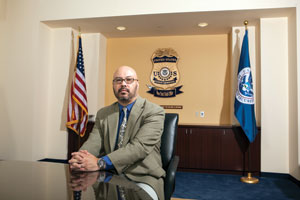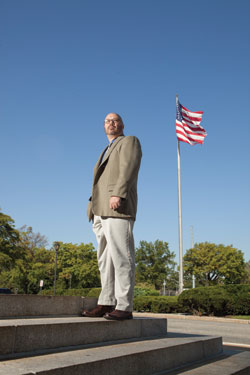From the ground up
“You can’t afford to miss on an aircraft,” says Don Anderson, a 1994 law and justice graduate who helped build today’s Federal Air Marshal Service.


Don Anderson traded in his car for a pick-up truck, bought some tools at Home Depot, and opened Anderson Construction. Thanks to relatives in the contracting business, work was steady for two years. By 1998, he was part of a crew renovating buildings at the Federal Aviation Administration’s technical center in Pomona, NJ.
The Federal Air Marshal Program, now the Federal Air Marshal Service (FAMS), would soon use those buildings for its new headquarters. On the job, Anderson ran into one of the program’s managers, and asked what exactly air marshals did.
“You’ve got to be kidding me,” Anderson said. “There’s a job like that? Are you hiring?” The manager looked at Anderson with a “come on, pal” expression. “You’re a construction guy,” he said respectfully. “We’re looking for someone with a military background.”
Anderson rattled off the highlights: security police specialist in the United States Air Force. Honorably discharged after six years, plus 19 awards and decorations. Veteran of Operations Desert Shield and Desert Storm, where he was detailed to the Secret Service for missions protecting Vice President Dan Quayle in his travels throughout Southwest Asia.
“We’re looking for someone with a college degree.”
Anderson, a 1994 TCNJ law and justice graduate, again had the right answer. Finally, the manager’s skepticism vanished. “Really. What are you doing? Give me your resume.”
A Different Path
Anderson, 45, has spent the last 14 years with FAMS. It’s way beyond a job at this point. He has grown with—and helped to grow—the agency. When he started, it was a small program under the FAA. Now, it’s blossomed into the law enforcement arm of the Transportation Security Administration: several thousand men and women continuously working to ensure the safety of those on board the more than 26,000 daily domestic and international flights that make up United States’ civil aviation. FAMS, says Anderson, now the deputy supervisory air marshal in charge (DSAC) for the air marshals’ New York City field office, “belongs” to him and its thousands of employees. “And I belong to it,” he adds.
The recent title brings Anderson closer to his home turf of central New Jersey and back to the field. He spent the last six years at FAMS’ northern Virginia headquarters in a variety of management roles, including deputy chief of staff, where he provided direction to the divisions and its officials, and assistant supervisory air marshal in charge of the Service Policy Compliance Unit, which Anderson compares to internal affairs.
“I’m trying to gain as much knowledge as I can and do as many different things as I can,” Anderson explains. The ultimate goal is to “bridge the gap between the field and headquarters.”
“He’s first among equals and always considers himself part of the team,” says Scott McShaffrey, deputy assistant director for the Office of Flight Operations, whom Anderson considers a mentor. “He has held a number of senior leadership positions and has done extremely well. He has always been resilient to whatever challenges are put in front of him.” Anderson remembers various graduation speakers—at his ceremony and others—imploring students not to fear mistakes. He embraced the message. “You open yourself to challenging yourself and not being afraid of the unknown.”

That attitude emerged before Anderson was putting up drywall in south Jersey. After high school, he attended Rutgers University but quit after one semester. “I was always one for studying on my own and learning as much as I could,” Anderson says. “As silly as it may sound, I found myself in the position of being bored with class because I knew the information. I stopped going to classes and showed up for tests and I passed.” Seeing how “it worked for my dad,” he joined the Air Force. That’s where Anderson matured and discovered the value of an education. He took overseas courses from the University of Maryland, earning an associate’s degree in six years. Eager to earn his bachelor’s degree at a less ponderous pace, Anderson left the Air Force in spring 1992.
Anderson’s brother Rick suggested TCNJ (then Trenton State College), his alma mater. “They said, ‘You have your associate’s degree. Guess what? We accept all of that,’” Anderson says. It got better. In class, he had the opportunity to interact with mayors, lawyers, prison administrators, and, for a course called “Incarceration,” a former prisoner. “You’re not getting textbook knowledge,” Anderson says. “You’re getting real-world knowledge of what it’s like to work in a prison.”
Anderson then attended Rutgers School of Law–Camden, where after attending two classes on the first day he “broke the record for the shortest time there.” Anderson admits that he didn’t consider the time and effort required. Besides, he wanted to get out of the classroom. He took a supervising job for a contract security firm, quitting after two frustrating years. That led to his abbreviated career in construction.
“You Can’t Afford to Miss On An Aircraft”
Anderson’s 4.0 GPA at the College got him hired under the air marshals’ Outstanding Scholars Program. There was still the small, draining matter of training: 10 weeks of criminal investigator training in Glynco, GA, followed by six weeks of federal air marshal training at the very facility Anderson renovated.
The first part of training emphasized academics, specifically mastering criminal codes and enforcing them. FAMS candidates had to know what happened when the plane, which is United States territory, landed in another country. The federal government has different agreements with different countries. International treaties play a role. And if that wasn’t enough to absorb, candidates had to learn about maintaining and fostering relationships with law enforcement in these countries.
Part two reviewed the job’s physical aspects. “Firearms or hand-to-hand or defensive measures are so very important,” Anderson says, “because, unlike a police officer on the ground—whom I have the utmost respect for—unlike their environment, we don’t have the ability to call back up.” And, he mentions with a veteran’s ease, “You can’t afford to miss on an aircraft.” Recruits who didn’t pass a firearms test on the last day—FAMS boasts the highest firearms standards of any federal agency—would not get a job. That message rattled Anderson at orientation. How do I tell my family if I don’t pass?
“Just the weight off your shoulders from graduating, or passing that test, I can’t even describe it,” he says. “It was the toughest mental challenge of my career.”
After The Attacks
Emily Anderson was born at 8:33 a.m. on September 11, 2001. Thirteen minutes later, everything unraveled, and Don knew time with his new daughter would be short. By the afternoon, he was at headquarters. Air traffic was grounded. All the marshals could do was sit and stew.
“Nobody wants anything bad to happen on a plane, but if something bad does happen, we want to be there,” Anderson says. “For us, it was a matter of feeling, I guess, a little disappointed that we weren’t on those aircrafts. Because we wish we would have been.”
In light of a terrorist attack using commercial airplanes, the federal government rapidly rebuilt the air marshal program for this strange new world. Field offices were built around the country. In response to an influx of marshals—33 men and women were suddenly insufficient—on domestic and international flights, a sophisticated scheduling methodology was developed. A state-of-the-art mission operations center was required to monitor missions and respond to incidents. Anderson, who had worked in a command center in the Air Force, was assigned to build it.
“I had no idea how to start, because you can work in an operations center,” he says, “but it doesn’t mean you know how to build one.” Anderson and his colleagues did not ask questions. “We just did it.”
“There were existing procurement rules and regulations, but I have never seen in my 20-year career such a collaborative effort to move forward,” McShaffrey says. “I do not know if you would be able to duplicate that type of effort, and I wouldn’t want to revisit the tragic circumstances that created it.” Adds Anderson, “None of the operations grew that fast and no one wrote a book on how to do that.”
Anderson plowed ahead, working with software and hardware engineers, architects, and other experts. “It got to the point where we forgot what a day off was,” Anderson says. “It was countless hours, countless days, but no one thought, ‘When are we going to take a day off?’ Everyone was singularly purposed.” The center, operational from the first day, was relocated to FAMS’ new headquarters in 2003. “You’re talking about a 24/7 operation that [Don] and his team took from infancy to maturity level,” McShaffrey says.
With his task accomplished, Anderson transferred to the next stop on his tour of FAMS: the Philadelphia field office. The days of needing a career change were long gone.
“The day I became an air marshal,” he says, “was the day I stopped looking for another job.”
All photos this page © Dustin Fenstermacher
Posted on November 28, 2012


